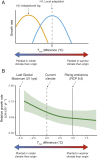Adaptational lag to temperature in valley oak (Quercus lobata) can be mitigated by genome-informed assisted gene flow
- PMID: 31767740
- PMCID: PMC6911187
- DOI: 10.1073/pnas.1908771116
Adaptational lag to temperature in valley oak (Quercus lobata) can be mitigated by genome-informed assisted gene flow
Abstract
Climate change over the next century is predicted to cause widespread maladaptation in natural systems. This prediction, as well as many sustainable management and conservation practices, assumes that species are adapted to their current climate. However, this assumption is rarely tested. Using a large-scale common garden experiment combined with genome-wide sequencing, we found that valley oak (Quercus lobata), a foundational tree species in California ecosystems, showed a signature of adaptational lag to temperature, with fastest growth rates occurring at cooler temperatures than populations are currently experiencing. Future warming under realistic emissions scenarios was predicted to lead to further maladaptation to temperature and reduction in growth rates for valley oak. We then identified genotypes predicted to grow relatively fast under warmer temperatures and demonstrated that selecting seed sources based on their genotype has the potential to mitigate predicted negative consequences of future climate warming on growth rates in valley oak. These results illustrate that the belief of local adaptation underlying many management and conservation practices, such as using local seed sources for restoration, may not hold for some species. If contemporary adaptational lag is commonplace, we will need new approaches to help alleviate predicted negative consequences of climate warming on natural systems. We present one such approach, "genome-informed assisted gene flow," which optimally matches individuals to future climates based on genotype-phenotype-environment associations.
Keywords: adaptational lag; climate change; ecological genomics; local adaptation; temperature.
Copyright © 2019 the Author(s). Published by PNAS.
Conflict of interest statement
The authors declare no competing interest.
Figures



References
-
- Urban M. C., Accelerating extinction risk from climate change. Science 348, 571–573 (2015). - PubMed
-
- McKay J. K., Christian C. E., Harrison S., Rice K. J., “How local is local?” A review of practical and conceptual issues in the genetics of restoration. Restor. Ecol. 13, 432–440 (2005).
-
- Hereford J., A quantitative survey of local adaptation and fitness trade-offs. Am. Nat. 173, 579–588 (2009). - PubMed

